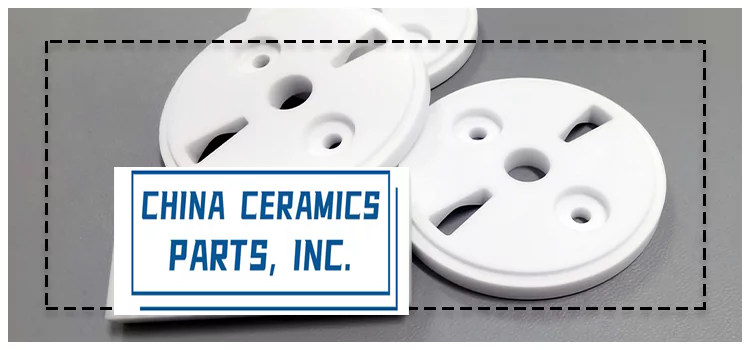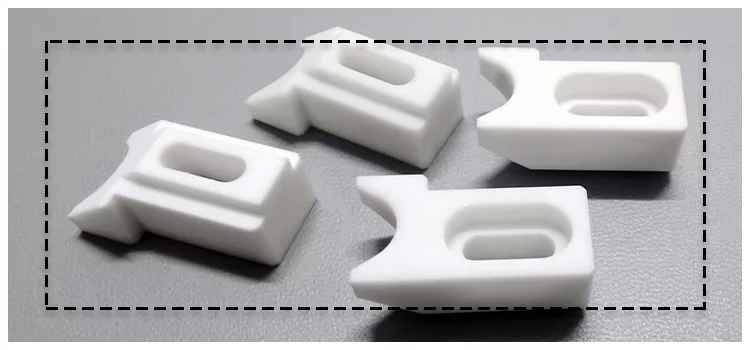Alumina ceramic use is wide.As a precision industrial ceramic, it has a series of advantages in performance. With the continuous development of science and technology, alumina ceramics have been widely used in various fields such as chemical industry, machinery manufacturing, and biomedicine, and with the improvement of performance, its application range has gradually expanded. Research on the properties of alumina is used in the production activities of many industries. Both have high practical significance.
1. High mechanical strength
The flexural strength of alumina porcelain sintered products can reach 250MPa, and the hot-pressed products can reach 500MPa. The purer the alumina component, the higher the strength. The strength can be maintained up to 900°C at high temperatures, as shown in the figure below. Utilizing the mechanical strength of alumina porcelain, it can be made into device porcelain and other mechanical components. The Mohs hardness of alumina ceramics can reach 9, plus it has excellent wear resistance, so it is widely used in the manufacture of knives, ball valves, grinding wheels, ceramic nails, bearings, etc., among which alumina ceramic knives and industrial valves are used The widest.
2. High resistivity and good electrical insulation performance
The room temperature resistivity is 1015Ω·cm, and the insulation strength is 15kV/mm. Using its insulation and strength, it can be made into substrates, sockets, spark plugs, and circuit shells.
3. High hardness
Mohs hardness of 9, coupled with excellent wear resistance, so it is widely used to manufacture tools, grinding wheels, abrasives, drawing dies, extrusion dies, bearings, etc. When using alumina ceramic cutters to process automobile engines and aircraft parts, high precision can be obtained at high cutting speeds.
4. High melting point, anti-corrosion
With a melting point of 2050°C, it has good resistance to the erosion of molten metals such as Be, Sr, Ni, Al, V, Ta, Mn, Fe, and Co. It also has high resistance to erosion by NaOH, glass and slag. Does not interact with Si, P, Sb, Bi in an inert atmosphere. Therefore, it can be used as refractory material, furnace tube, glass drawing crucible, hollow ball, fiber, thermocouple protective cover, etc.
5. Excellent chemical stability
Many complex sulfides, phosphides, arsenides, chlorides, nitrides, bromides, iodides, oxides and sulfuric acid, hydrochloric acid, nitric acid, and hydrofluoric acid do not interact with alumina. Therefore, alumina can be made into pure metal and single crystal growth crucibles, human joints, artificial bones, etc.
6. Optical characteristics
It can be made into light-transmitting materials (transparent alumina porcelain) to make sodium vapor lamps, microwave fairings, infrared windows, laser oscillation elements, etc.
7. Ionic conductivity
Used as solar cell material and battery material.
The main application of alumina ceramics
1. Mechanical aspects
Alumina ceramic cutters are widely used in hard material cutting, high-speed steel cutting, ultra-high-speed cutting and other difficult processing due to their high hardness, strong high-temperature mechanical properties, good wear resistance, good chemical stability, and not easy to bond with metals. Cutting of materials. The optimal cutting speed of alumina ceramic tools is higher than that of ordinary cemented carbide tools, which can greatly improve the cutting efficiency of different materials.
①Pure alumina ceramic cutter
Pure alumina ceramic tools refer to high-purity alumina ceramics containing only a small amount of other oxides, and the purity of alumina is more than 99%. In pure alumina ceramics, zirconia can be added as a sintering aid to improve its fracture toughness. In the preparation of ceramic tools, effective control of the original purity and grain size is realized, and other components are added to form two phases or exist in the form of solid solution in the matrix of alumina-based composite ceramics and whisker-reinforced ceramics. These technologies make up for the shortcomings of pure alumina ceramics, thereby improving its cutting performance and durability. Because of the high temperature performance and wear resistance of pure alumina ceramic tools, but the low bending strength and poor impact resistance, it is more and more replaced by various composite alumina ceramic tools.
②Composite alumina ceramic cutter
In composite ceramics, there are several composite directions: alumina-carbide ceramic tools, alumina-carbide-cermet tools, alumina-nitride or boride ceramic tools, etc. For example, alumina-carbide ceramic tools, adding certain carbides (TiC, WC, TaC, NbC, Mo, C, Cr, C2, etc.) to alumina can improve its strength, wear resistance, and impact resistance As well as high temperature performance, among the additives, TiC has the most application. Compared with pure alumina ceramics, the flexural strength of alumina-carbide composite ceramics is better than pure alumina ceramics at room temperature or high temperature. . This composite tool is suitable for high-speed roughing and finishing of hard-to-machine materials such as wear-resistant cast iron, hardened steel and high-strength steel.
③Toughened alumina ceramic tool
Toughened alumina ceramic tool refers to the addition of toughening or reinforcing materials to the alumina matrix. Currently commonly used toughening methods include: Zr02 phase transformation toughening, whisker toughening, and second phase particle dispersion toughening.
2. Industrial
At present, there are many types of industrial valves. The commonly used valves for the alumina industry are plug valves, gate valves, globe valves, ball valves, etc.
Ball valve: The main feature of the ball valve is its compact structure, reliable sealing, simple structure and convenient maintenance. The sealing surface and the spherical surface are always in a closed state, which is not easy to be eroded by the medium. It is easy to operate and maintain. It is suitable for water, solvent, acid and natural gas General working media, but also suitable for media with harsh working conditions, such as oxygen, hydrogen peroxide, methane and ethylene, etc., are widely used in various industries.
Cock valve: It is widely used in oilfield exploitation, transportation and refining equipment, and also widely used in petrochemical, chemical, gas, natural gas, liquefied petroleum gas, HVAC industry and general industry.
Gate valve, stop valve: it can be widely used as regulating and intercepting devices on the pipelines of tap water, sewage, construction, petroleum, chemical industry, food, medicine, textile, electric power, shipbuilding, metallurgy, energy system, etc.
3. Electronics and electricity
In terms of electronics and electricity, there are various alumina ceramic base plates, substrates, ceramic membranes, transparent ceramics, and various alumina ceramic electrical insulating ceramics, electronic materials, magnetic materials, etc., among which alumina transparent ceramics and substrates are used The widest.
4. Chemical industry
In chemical applications, alumina ceramics also have a wide range of uses, such as alumina ceramic chemical filler balls, inorganic microfiltration membranes, and corrosion-resistant coatings. Among them, alumina ceramic membranes and coatings are the most studied and applied.
①Alumina ceramic membrane:
The membrane is divided into organic polymer membrane and inorganic membrane. Since the 1980s, the research and development of alumina ceramic membrane, especially porous alumina ceramic membrane, has been greatly improved. Occupies an important position. Alumina ceramic membranes have a large number of applications in the purification of industrial water processing, seawater desalination, gas separation, and catalytic reactions. Therefore, ceramic inorganic membranes have increasingly received extensive attention from the scientific and technological circles and the industry.
②Alumina coating:
Titanium alloy material is highly oxidized at high temperature. In order to improve its performance, aluminum oxide coating can be coated on the surface of titanium alloy material, which can also improve the corrosion resistance and high temperature oxidation resistance of titanium alloy material.
5. Medical aspects
In medicine, alumina is more used to make artificial bones, artificial joints, artificial teeth and so on. Alumina ceramics have excellent biocompatibility, biological inertness, physical and chemical stability, high hardness and high wear resistance, and are ideal materials for the preparation of artificial bones and artificial joints. But it has the same shortcomings as other ceramic materials, such as high brittleness, low fracture toughness, high machining technology difficulty, and complex technology, so further research and application are needed.
6. Architectural and sanitary ceramics
In building sanitary ceramics, alumina ceramic products can be seen everywhere, such as alumina ceramic lining bricks, grinding media, sticks, ceramic protection tubes, and alumina refractory materials. Among them, alumina ball milling media is the most widely used. Alumina ball milling media has the characteristics of suitable hardness, moderate density, wear resistance, corrosion resistance and low price. Therefore, most of the raw materials for building and sanitary ceramics are processed with alumina ball milling media.
7. Other aspects
Alumina ceramics is currently one of the most researched and widely used materials among new materials. In addition to the above applications, it is also widely used in other high-tech fields, such as aerospace, high-temperature industrial furnaces, composite reinforcement, etc. .
①Aerospace
Alumina-based fibers are widely used in aerospace, which has high strength, high temperature resistance, oxidation resistance, corrosion resistance and many other properties. Alumina can be prepared into high-temperature heat-resistant fibers and used in insulation tiles and flexible insulation materials on space shuttles. Not only that, the use of alumina fiber can also be used to reinforce metal-based and ceramic-based composite materials, and is widely used in nozzles in supersonic jets and gaskets in rocket engines.
②High temperature industrial furnace
In the field of high-temperature industrial furnaces, alumina-based short fiber materials are mainly used as heat preservation and refractory materials, because it has the advantages of low density, good heat insulation, and small heat capacity. These advantages can not only reduce the weight of the high-temperature furnace, but also make the temperature control of the high-temperature furnace accurate, and thus more energy-saving.
③Composite reinforcement
Alumina fiber-reinforced metal matrix composites have the characteristics of good mechanical properties, high wear resistance, low expansion coefficient, and high hardness. This is due to the good wettability and low interface reaction between the alumina fiber and the metal matrix. These materials have been used in the manufacture of automobile pistons and air compressor blades. Alumina fiber also has a good bond with resin, so it can be prepared into alumina/resin composite material, which has the characteristics of large elasticity and high hardness, and can be used in the manufacturing industries of sports equipment such as fishing rods, golf clubs, skis, tennis rackets, etc. .






